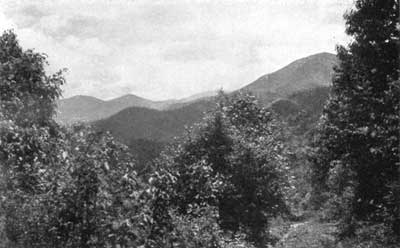MENU
![]() Great Smoky Mountains
Great Smoky Mountains
|
Glimpses of Our National Parks |
 XXIII
XXIII

THE GREAT SMOKY MOUNTAINS NATIONAL PARK
NORTH CAROLINA-TENNESSEE
Special Characteristic: Includes the Most Massive Mountain Uplift in the Eastern Section of the United States—A Veritable Paradise for the Hiker and Fisherman— Primeval Forests
 A few peaks of the Great Smoky Range—Great Smoky Mountains National Park |
"MYSTERIOUS, indeed", wrote the late Horace Kephart, "this Smoky Mountain region has been ever since the first white explorer, De Soto, heard of it nearly four centuries ago. At intervals of many years a few adventurous botanists and geologists have roamed through its great forest—Bartram, Michaux, Gray, Buckley, Mitchell, Guyot, and others—but their reports reached none but scientific circles. The wildest and most picturesque highland east of the Rockies remained virtually unknown until about 10 years ago. Even today there are gulfs in the Smokies that no man is known to have penetrated.
"Nearly always there hovers over the high tops and around them a tenuous mist, a dreamy blue haze, like that of Indian summer, or deeper. Often it grows so dense as almost to shut out the distant view, as smoke does that has spread from a far-off forest fire. Then it is a 'great smoke' that covers all the outlying world; the rim of the earth is but a few miles away; beyond is mystery, enchantment."
PLANT LIFE REACHES HIGHEST EXPRESSION
The Great Smoky Mountains run the entire length of the park, one of their ridges carrying the boundary line between the States of Tennessee and North Carolina. Their slopes and crests are covered with a luxuriant growth of trees and shrubs. The southern Appalachians have been recognized by students of plant geography as one of the outstanding vegetational centers of the world because of the high rainfall, good drainage, and long growing season. In the Great Smoky Mountains region the plant life of the southern Appalachians reaches its highest expression.
There are 147 varieties of trees alone. The park contains the larges tract of hardwood in America, and the idea has been suggested that probably the hardwoods of the Nation, and perhaps of the world, originated in this region. Here, too, is the country's largest virgin forest of red spruce.
The highest peaks in the park are covered with unusually dense forests of spruce, balsam, and some hemlock, while the intermediate mountains are clothed with hardwood, beech predominating. Hemlock, buckeye, the tulip tree, chestnut, and a number of other species reach their maximum growth in this favored place.
Other giants include a huge old grapevine, 60 inches in circumference at a point 12 feet above the ground, which is supported by five large trees. It is estimated to be at least 150 years old.
Equally as famous as the forests are the flowering shrubs of the Great Smokies. Among these are the white-flowered rhododendron, the true laurel or calico bush with pink-spotted flowers, the amazing flame azalea, and the white honeysuckle.
Many of the mountaintops are known as "balds" because they lack the waving tresses provided by the great stands of trees that cover most of the peaks. But they are far from bald, being covered with grass and flowering shrubs.
Once the Great Smokies region was the native haunt of the deer, the bear, the wildcat, many smaller animals, and several species of game birds. During the days of unrestricted hunting, before the area became a wildlife sanctuary as a national park, the larger animals had become practically extinct. Under the protection now afforded, and with restocking with deer and other native species, the park again will become the range of wild animals.
There are 600 miles of ideal trout streams in the park—sparkling waters dancing down the mountain sides, hurrying on their way to join the larger waters that eventually will carry them to the sea.
THE CHEROKEES
At one time this whole region was the home of the Cherokee Indian. In 1838, when white men desired the lands, the greater part of the tribe was moved to Oklahoma. A fair-sized band, loving their own home intensely, escaped to the mountain fastnesses where they lived for years until permitted to occupy the Qualla Reservation, immediately south of the park. There they may be seen today, living according to modern standards but still preserving many of their ancient ceremonies and sports.
PARK COMPLETED AND DEDICATED
On September 2, 1940, 10 years after the area received limited national park status, the Great Smoky Mountains National Park was dedicated to public use by President Franklin D. Roosevelt.
This ceremony marked a milestone in park history. Congress, in providing for its establishment, had stipulated that until the park included the 427,000 acres designated as essential it could not be developed for public use. It did, however, permit its establishment, for protective purposes only, upon acceptance by the Federal Government of 150,000 acres. This smaller area was accepted in 1930. Later congressional legislation (1934) reduced the total minimum area for development to 400,000 acres.
When Congress passed the legislation providing for the park's establishment it was estimated that $10,000,000 would be needed to acquire all the land within the area. All of this land was privately owned. A great portion, practically primitive in character, was in the hands of lumber companies. About one-half of the purchase price was pledged by the States of North Carolina and Tennessee and their citizens, and the other half contributed on a basis of matching dollar for dollar by the Laura Spelman Rockefeller Memorial in memory of Laura Spelman Rockefeller. Later, due to increased costs and bank failures, the purchase funds were augmented by $2,300,000 of Federal funds, by Presidential allocation of emergency funds, and congressional appropriation.
 Top
Top
Last Modified: Fri, Sep 1 2000 07:08:48 pm PDT
http://www.cr.nps.gov/history/online_books/glimpses1/glimpses23.htm
![]()
